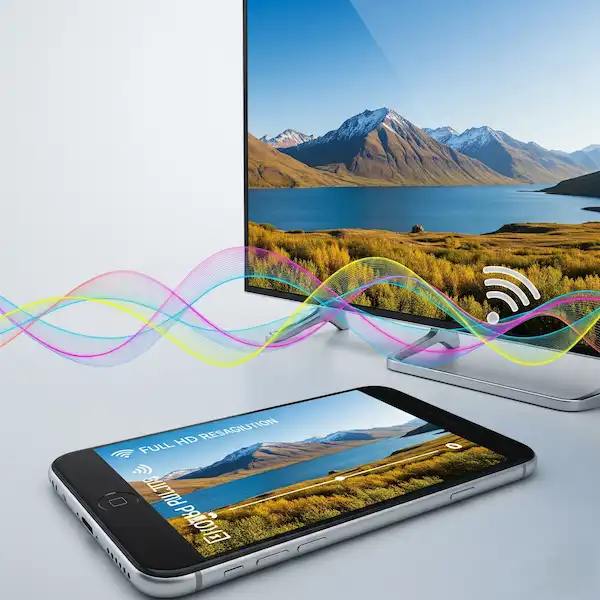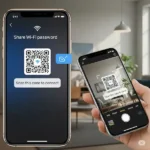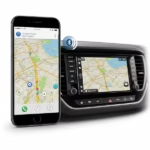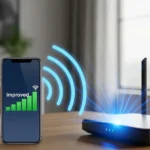Connect Your Phone to Your Smart TV: A Comprehensive Guide for iPhone and Android Users
Your smartphone is more than just a communication device – it’s a portable entertainment hub. Want to share photos from your recent trip on a big screen, stream your favorite movie, or even mirror your phone’s entire display for a presentation? Connecting your smartphone, iPhone or Android phone, to your smart TV opens up a world of possibilities. Read on to discover the easiest methods to connect your phone to your smart TV.
Why Connect Your Phone to Your Smart TV?
- Bigger Screen Experience: Enjoy photos, videos, and games on a larger, more immersive display.
- Content Sharing: Easily share content with friends and family without crowding around a small phone screen.
- Presentations: Mirror your phone’s screen for business or educational presentations.
- Convenience: Access streaming apps and control playback directly from your phone.
- Gaming: Play mobile games on your TV for a console-like experience.
Connect Your iPhone to Your Smart TV
iPhones primarily use Apple’s proprietary AirPlay technology for wireless screen mirroring and content streaming. Many modern smart TVs (from brands like Samsung, LG, Sony, and Vizio) now come with AirPlay 2 built-in. If your TV doesn’t, you can use an Apple TV streaming device.
1. Wireless Connection (AirPlay)
Requirements:
- iPhone (iPhone 4s or later)
- Apple TV or an AirPlay 2-compatible Smart TV
- Both devices connected to the same Wi-Fi network
Steps to Mirror Your iPhone Screen:
- Connect to Wi-Fi: Ensure your iPhone and your Apple TV/Smart TV are connected to the same Wi-Fi network.
- Open Control Center:
- iPhone X or later, or iPad with iPadOS 13 or later: Swipe down from the upper-right corner of the screen.
- iPhone 8 or earlier, or iOS 11 or earlier: Swipe up from the bottom edge of the screen.
- Tap Screen Mirroring: Look for the icon with two overlapping rectangles.
- Select Your TV: A list of available AirPlay devices will appear. Tap on your Apple TV or AirPlay-compatible smart TV.
- Enter Passcode (if prompted): If a passcode appears on your TV screen, enter it on your iPhone.
- Stop Mirroring: To stop, open Control Center, tap Screen Mirroring, and then tap “Stop Mirroring.”
Steps to Stream Videos or Photos (Casting):
- Connect to Wi-Fi: Ensure your iPhone and your Apple TV/Smart TV are connected to the same Wi-Fi network.
- Open the App: Go to the Photos app, a video streaming app (e.g., YouTube, Netflix), or any app with video content you want to stream.
- Tap the AirPlay Icon: Look for the AirPlay icon (a rectangle with an arrow pointing up from the bottom). In some apps, you might need to tap a “Share” button first.
- Choose Your TV: Select your Apple TV or AirPlay 2-enabled smart TV from the list of devices.
- Stop Streaming: To stop, tap the AirPlay icon in the app and select your iPhone from the list.
2. Wired Connection (HDMI Adapter)
If you don’t have an Apple TV or an AirPlay-compatible smart TV, or if you prefer a more stable wired connection, you can use a Lightning Digital AV Adapter.
Requirements:
- iPhone with a Lightning port
- Lightning Digital AV Adapter (Apple official recommended for best compatibility)
- HDMI cable
- Smart TV with an HDMI port
Steps:
- Connect Adapter to iPhone: Plug the Lightning Digital AV Adapter into your iPhone’s Lightning port.
- Connect HDMI Cable: Connect one end of the HDMI cable to the adapter and the other end to an available HDMI port on your smart TV.
- Select Input on TV: Using your TV remote, change the input source (or “Source” or “Input”) to the HDMI port where your iPhone is connected.
- Enjoy: Your iPhone screen should now be mirrored on your TV. You may need to adjust your TV’s display settings for optimal viewing.
Connect Your Android Phone to Your Smart TV
Android offers several methods for connecting to smart TVs, ranging from built-in casting features to wired adapters.
1. Wireless Connection (Built-in Casting/Screen Mirroring)
Most Android phones come with built-in casting or screen mirroring capabilities (often called “Smart View” on Samsung, “Cast” on Google Pixel, or “Screen Share” on LG). Your smart TV likely supports one or more of these technologies, such as Google Cast (Chromecast built-in) or Miracast.
Requirements:
- Android Phone
- Smart TV with Google Cast (Chromecast built-in) or Miracast support
- Both devices connected to the same Wi-Fi network
Steps (General for Google Cast/Chromecast built-in):
- Connect to Wi-Fi: Ensure your Android phone and smart TV are connected to the same Wi-Fi network.
- Open a Cast-Enabled App: Launch an app like YouTube, Netflix, Google Photos, or Google TV.
- Tap the Cast Icon: Look for the Cast icon (a screen with a Wi-Fi signal in the corner). This icon usually appears within the app’s video player or near the content.
- Select Your TV: A list of available casting devices will appear. Select your smart TV.
- Enjoy: The content will start playing on your TV. You can control playback from your phone.
- Disconnect: To stop casting, tap the Cast icon again and select “Disconnect.”
Steps (General for Screen Mirroring/Miracast):
- Connect to Wi-Fi: Ensure your Android phone and smart TV are connected to the same Wi-Fi network.
- Enable Screen Mirroring on TV: On your smart TV, navigate to the “Screen Mirroring,” “Screen Share,” or “Miracast” setting and enable it. The exact name varies by TV brand.
- Enable Screen Mirroring on Android:
- Swipe down from the top of your screen to access the Quick Settings panel.
- Look for an icon like “Smart View,” “Screen Cast,” “Wireless Display,” or “Cast.” The name and icon vary by Android device and manufacturer.
- Tap on it.
- Select Your TV: Your phone will scan for nearby Miracast-compatible devices. Select your smart TV from the list.
- Accept Connection: You might need to accept the connection on your TV.
- Enjoy: Your Android phone’s entire screen will now be mirrored on your TV.
- Stop Mirroring: To stop, go back to the screen mirroring setting on your phone and tap “Disconnect” or “Stop Mirroring.”
2. Using a Streaming Device (Roku, Amazon Fire TV Stick, Chromecast Dongle)
If your smart TV doesn’t have built-in casting or Miracast, or if you want enhanced streaming capabilities, you can use a dedicated streaming device.
Requirements:
- Android Phone
- Streaming device (Roku, Amazon Fire TV Stick, Google Chromecast)
- Both devices connected to the same Wi-Fi network
Steps (General):
- Set up Streaming Device: Connect and set up your streaming device to your TV according to its instructions.
- Connect to Wi-Fi: Ensure your Android phone and the streaming device are on the same Wi-Fi network.
- For Chromecast:
- Open a cast-enabled app (e.g., YouTube, Netflix).
- Tap the Cast icon and select your Chromecast device.
- For Roku/Fire TV Stick (Casting from Apps):
- Many apps (like YouTube, Netflix) have a built-in cast icon that can directly send content to Roku or Fire TV devices.
- Tap the Cast icon within the app and select your Roku or Fire TV device.
- For Roku/Fire TV Stick (Screen Mirroring – Android only for Fire TV):
- Roku: On your Roku remote, go to
Settings > System > Screen Mirroringand ensure it’s enabled. On your Android phone, enable screen mirroring (as described in the previous section) and select your Roku. - Amazon Fire TV Stick: Hold down the Home button on your Fire TV remote until a menu pops up, then select “Mirroring.” On your Android phone, go to
Settings > Connected devices > Castand select your Fire TV Stick.
- Roku: On your Roku remote, go to
3. Wired Connection (USB-C to HDMI, MHL)
For Android devices, wired connections can be a bit more varied due to the diverse hardware. Modern Android phones with USB-C ports often support DisplayPort Alternate Mode (Alt Mode), allowing for direct video output. Older phones might use MHL (Mobile High-definition Link).
Requirements:
- Android Phone (with USB-C supporting DisplayPort Alt Mode or MHL support)
- USB-C to HDMI adapter/cable OR MHL adapter/cable
- HDMI cable (if using an adapter)
- Smart TV with an HDMI port
Steps (General):
- Determine Your Phone’s Compatibility: Check your phone’s specifications or manufacturer’s website to see if it supports DisplayPort Alt Mode via USB-C or MHL.
- Obtain the Correct Adapter/Cable:
- USB-C to HDMI: If your phone supports DisplayPort Alt Mode, a simple USB-C to HDMI cable or adapter will work.
- MHL: If your phone supports MHL, you’ll need an MHL-compatible adapter (often Micro-USB to HDMI) and an HDMI cable. Some MHL adapters may require external power.
- Connect:
- Plug the adapter into your phone’s charging port.
- Connect one end of the HDMI cable to the adapter (or directly to the USB-C HDMI cable) and the other end to an HDMI port on your TV.
- Select Input on TV: On your TV remote, change the input source to the HDMI port your phone is connected to.
- Enjoy: Your Android screen should now be mirrored on your TV. Some Android phones with USB-C DisplayPort Alt Mode may even offer a “desktop” mode, treating your TV as a second monitor.
Troubleshooting Tips to Connect Your Phone to Your Smart TV
You’ve got your smartphone and smart TV, but they’re not quite playing nice? Don’t worry, many common problems when connecting these devices can be solved with a few simple troubleshooting steps. Here’s a breakdown of the most frequent issues and how to tackle them:
General Troubleshooting Steps (Applicable to all connection types)
- Check Wi-Fi Network: This is the most common culprit.
- Ensure both your smartphone and smart TV are connected to the same Wi-Fi network. Even slightly different network names (e.g., “MyHomeWifi” vs. “MyHomeWifi_5G”) can prevent connection.
- Verify both devices have a strong and stable Wi-Fi signal. Weak signals can lead to buffering, disconnections, or an inability to find the TV. Move closer to your router if possible.
- Restart Everything: The classic tech fix, and for good reason!
- Restart your smartphone: Turn it off completely, wait 30 seconds, then turn it back on.
- Restart your smart TV: Unplug it from the power outlet for at least 30 seconds, then plug it back in. This performs a hard reset, which is often more effective than just turning it off with the remote.
- Restart your Wi-Fi router/modem: Unplug it from the power for about 60 seconds, then plug it back in. Wait a few minutes for it to fully boot up and re-establish internet connection before trying to connect your devices again.
- Software Updates: Outdated software can cause compatibility issues.
- Update your smartphone’s operating system: Check for any pending iOS or Android updates in your phone’s settings.
- Update your smart TV’s firmware/software: Go to your TV’s settings menu (usually under “System,” “About,” or “Support”) and look for a “Software Update” option. Keep your TV’s software current.
- Check Device Compatibility:
- Not all devices support every casting/mirroring technology. For instance, if your TV doesn’t have AirPlay 2, your iPhone won’t be able to mirror directly without an Apple TV. Similarly, older Android phones or TVs might not support certain casting protocols. Refer to your device manuals or manufacturer’s websites to confirm compatibility.
Troubleshooting Wireless Connections (AirPlay, Chromecast, Miracast)
Specific to AirPlay (iPhone):
- AirPlay Enabled on TV: On your AirPlay-compatible smart TV or Apple TV, go to its settings (often under “AirPlay and HomeKit” or “Network”) and ensure AirPlay is enabled. Check for any access restrictions or password requirements that might be preventing connection.
- Firewall Settings (if using a Mac for AirPlay): If you’re trying to AirPlay from a Mac and encountering issues, check your Mac’s firewall settings to ensure they aren’t blocking AirPlay connections.
- Bluetooth Interference: While AirPlay primarily uses Wi-Fi, it can use Bluetooth for device discovery. Try toggling Bluetooth off and on on your iPhone, or moving away from other Bluetooth devices that might be causing interference.
Specific to Chromecast / Google Cast (Android & built-in TVs):
- Chromecast/Google Cast App Status: On some Google TVs or Android TVs, the Google Cast or Google Cast Receiver app might be disabled. Go to your TV’s app settings, find “Google Cast” or “Google Cast Receiver,” and ensure it’s enabled.
- Clear Cache/Data for Casting Apps: On your Android phone, go to the settings for the app you’re trying to cast from (e.g., YouTube, Netflix) and clear its cache and data. On your TV, you might also try clearing data for the Google Cast app or “External Input Services” (on Sony TVs).
- Router Channels: Sometimes, network congestion on your Wi-Fi channel can interfere. Access your router settings (usually via a web browser on a computer connected to your Wi-Fi) and try changing the Wi-Fi channel to a less congested one.
- Router Firmware: Ensure your Wi-Fi router’s firmware is up to date. Check the router manufacturer’s website for instructions.
Specific to Miracast (Android & Smart TVs):
- Enable Screen Mirroring on TV: Ensure the “Screen Mirroring,” “Screen Share,” or “Miracast” function is actively enabled and discoverable on your smart TV’s settings.
- Device Drivers (if using a Windows PC): If you’re mirroring from a Windows PC, outdated graphics or network drivers can cause Miracast issues. Update them through Device Manager.
- Wi-Fi Band: Miracast primarily operates over the 2.4 GHz Wi-Fi band. If your phone or TV is locked to a 5 GHz band, it might not find the Miracast connection. Check your device’s Wi-Fi settings to ensure 2.4 GHz is enabled or preferred.
Troubleshooting Wired Connections (HDMI Adapter)
- Correct Input Source: On your TV, use the remote control to select the correct HDMI input (e.g., HDMI 1, HDMI 2) that your phone is connected to. It’s a common oversight!
- Phone HDMI Output Support:Crucially, not all phones support video output via their USB-C or Lightning port.
- iPhones: Require a Lightning Digital AV Adapter. A standard Lightning-to-USB-C cable won’t transmit video.
- Android (USB-C): Your phone’s USB-C port needs to support DisplayPort Alternate Mode (Alt Mode) to transmit video directly. Many budget or older Android phones may not have this feature. Check your phone’s specifications. If it doesn’t support Alt Mode, a wired connection isn’t possible directly from the USB-C port for video.
- Android (Micro-USB): Older Android phones might have supported MHL (Mobile High-definition Link), requiring a specific MHL adapter.
- Faulty Cables or Adapters: HDMI cables can go bad, and adapters can be incompatible or faulty.
- Try a different HDMI cable.
- Try a different adapter if you have one, or test your current adapter with another compatible device if possible.
- Ensure the cable and adapter are securely plugged in on both ends. HDMI connections can sometimes be a bit loose.
- External Power for Adapter: Some HDMI adapters (especially MHL adapters or certain USB-C adapters) require external power to function. If your adapter has a port for it, ensure it’s connected to a power source.
- TV Resolution Compatibility: In rare cases, your phone might be trying to output a resolution or refresh rate that your TV doesn’t support. Check your phone’s display settings to see if you can lower the output resolution.
- HDCP Issues: HDCP (High-bandwidth Digital Content Protection) is a copy protection scheme. Sometimes, issues with HDCP handshake between your phone/adapter and TV can prevent a picture. Ensuring all devices are updated can sometimes resolve this.
By systematically going through these troubleshooting steps, you should be able to identify and resolve most common problems when you connect your phone to your smart TV. If the issue persists after trying these solutions, it might indicate a hardware problem with either your phone, TV, or the connecting accessories, and you may need to contact technical support for your device.
Additional helpful information
Some help with a trouble WIFI connection – Fix WIFI Disconnects on iPhone & Android



